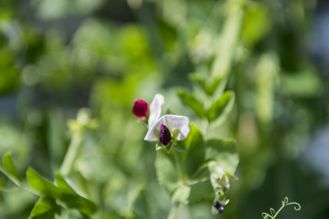Pea

Pea is an important source of protein, starch and micronutrients, and importantly has one of the smallest carbon footprints of all crops. Pea is a nitrogen fixing crop, which reduces the need for fertilizer in rotations and is now in high demand as an alternative and plant-based source of protein. At Church Farm, different types of pea are grown within a large cage to protect against predation by birds and animals.
Professor Claire Domoney’s group focuses on seed compositional traits influencing nutritional quality. Claire leads the Defra-funded UK Pulse Crop Genetic Improvement Network (PCGIN). The results of genetic studies of agronomic and seed quality traits are made available for UK pulse breeding. As part of this network, Dr. Sanu Arora is studying genetic sources of resistance to pea diseases, such as downy mildew.
Dr Arora and Professor Lars Ostergaard are multiplying a set of pea accessions, which are very diverse and have sequenced genomes. The seeds will be distributed within a large multi-national project where many partners will study a wide range of traits, including resistance or susceptibility to disease.
Dr Janneke Balk is testing pea mutants that accumulate high concentrations of iron. Dr Ahmed Warsame (in the Balk group) is running microplot trials of accessions that show extreme variation in nutritional traits, including oligosaccharide and phytate content. Phytic acid can inhibit iron and zinc bioavailability.
Aryana Zardkoohi-Burgos and Tracey Rayner (Domoney group) are monitoring how pea mutants that lack the majority of the raffinose oligosaccharides in their seeds perform under field conditions. The raffinose family of oligosaccharides can cause flatulence, which can be a negative trait for some consumers. However, these compounds have been shown to have beneficial effects in the large intestine by promoting the growth of beneficial bacteria by acting as a prebiotic.
Dr Julie Hofer (Domoney group) is testing near-isogenic pea lines with contrasting pod colour under field conditions, a trait that is of interest to the vegetable industry.
Dr Anne Edwards (Professor Cathie Martin’s group) is bulking up seed from a line of European Grass Pea, which has been sequenced and its genetic code revealed. This seed will be distributed to other grass pea researchers around the world so that all the scientists are working with the same starting material. Grass pea has amazing capability to survive drought. However, as a main food source, it can cause paralysis as it contains a neurotoxin (ODAP). Research is looking into varieties that produce less of this toxin. Read more about this research – How a plant with a toxic past can become a climate-smart crop of tomorrow.
